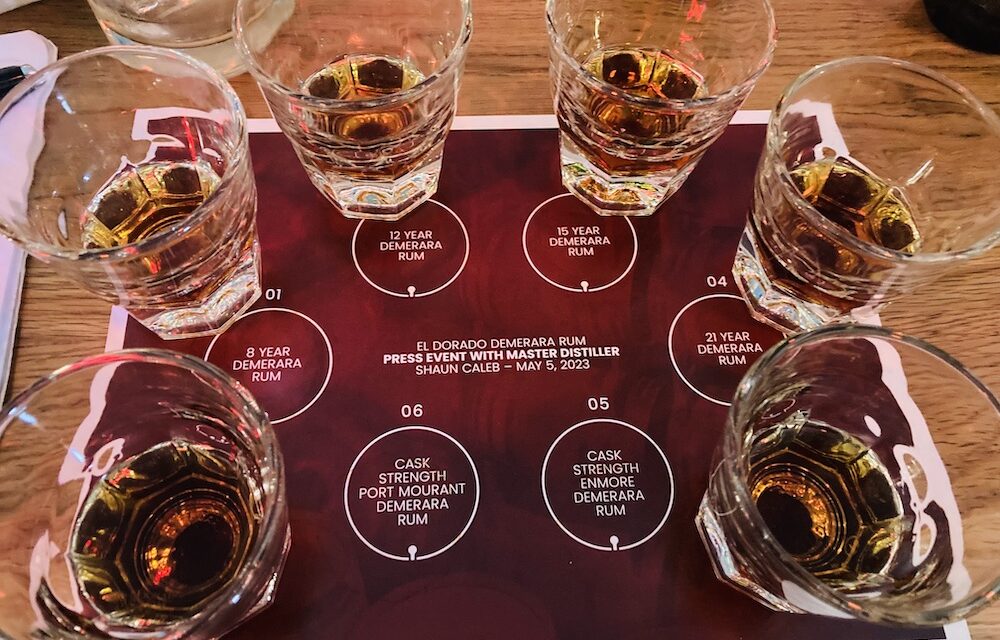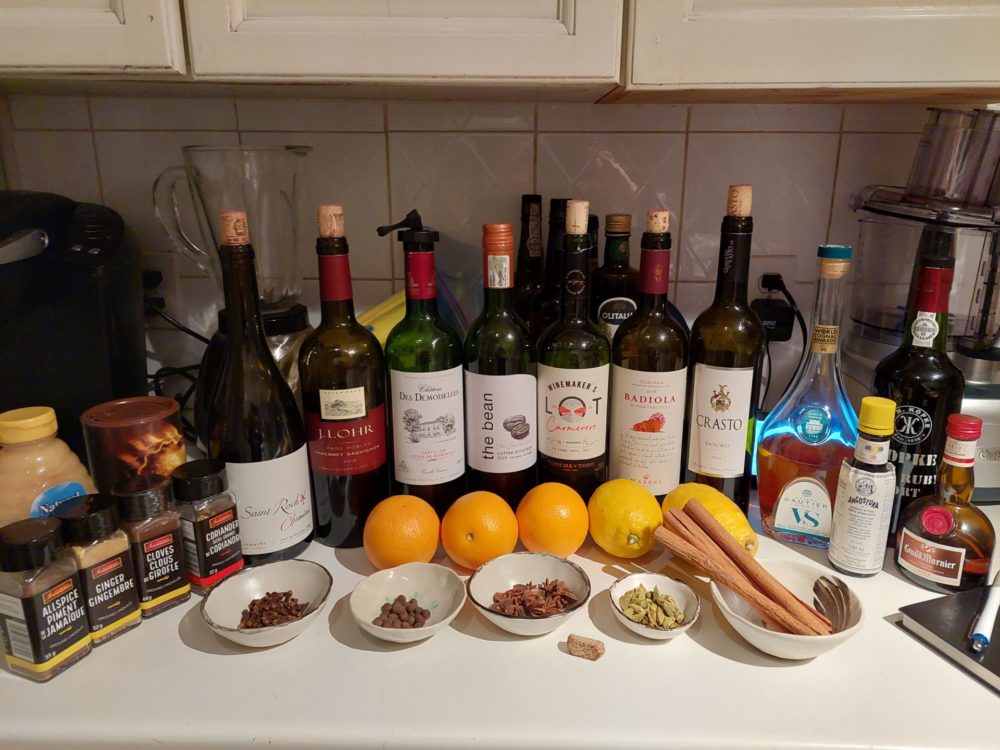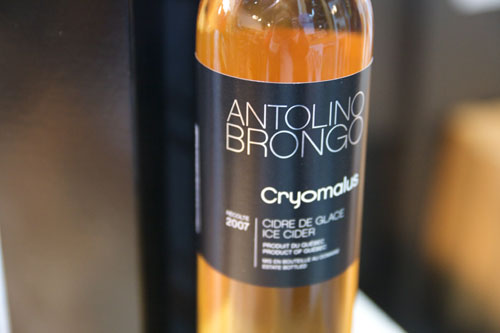By Patricia Noonan
Rum is one of the most fascinating spirits, but sadly, most consumers only know it in the ubiquitous rum and coke form. (Don’t get me wrong, I have nothing against that combination, but when it comes to the amber gold, I’ll take mine simply, with a splash of water or in a a classic cocktail like a Daiquiri, preferably a Hemingway Daiquiri, which uses Maraschino liqueur or a mojito…
There is so much to learn, and with El Dorado Rum, Demerara Rum from Guyana, there is so much to enjoy. I had the chance to meet the El Dorado Master Distiller, Shaun Caleb, when he was in Toronto for a tasting of six rums from their portfolio, imported by Woodman Wines & Spirits. There are lots of rums from all over the world, but Demerara rum has its own distinct character, as does El Dorado rum, especially due to the historic stills used in their production. While I love demerara sugar, the rum is not named for the style of sugar but for the location of the original Demerara Distillers, located near the Demerara River in Guyana, so it’s more of an appellation. While there are varying styles of sugar cane, they do not figure into the production. It’s more about the distillation method and controls in production. Cask selection and ageing are significant, as Guyana is an equatorial country, so that changes the game in a big but magnificent way. Consistent temperatures with humidity speed up the aging process, and the magical interplay of air and oak porosity, the rum to pick up all the nuances of the oak, like any other fine whisky or cognac.
But I had more specific questions in mind after the tasting with Mr. Caleb. At El Dorado, there are four historic stills being used in production. We tasted the El Dorado 8, 12, 15, 21 YO, and the Cask Strength Enmore and Port Mourant. I’ll highlight in bold, along with my tasting notes, Shaun’s information about the use of the stills.
Tasting Notes
El Dorado 8 Year Old Demerara Rum
Appearance – Rich amber
Nose – Floral, honeysuckle, almond, candied orange peel
Palate – Smooth
Finish – Long spiced finish of nutmeg, cinnamon, crushed Demerara sugar
![]()
The 8 YO blends together components of the Enmore Wooden Coffey Still, with light rum from the French Savalle Still, and a small amount of the Port Mourant Double Wooden Pot Still.
El Dorado 12 Year Old Demerara Rum
Appearance – burnished gold
Nose – Banana, hints of vanilla, creme caramel
Palate – Smooth, silky spice bomb, mostly ginger and cinnamon
Finish – Lengthy finish, replaying aromas and flavours.
![]()
The 12 YO also includes the Enmore Wooden Coffey Still, as well as the Diamond Copper Coffey Still. Although one still is made of wood and the other of copper exterior, they both have copper plates and copper pipes winding internally, which provides the copper surface that polishes the spirit and catalyzes the formation of fruity/floral esters during the distillation of the spirit. The presence of those volatile esters makes the spirit lively and opens up.
El Dorado 15 Year Old Demerara Rum
Appearance – Deep gold hue
Nose – Citrus, vanilla, sugar, spice tea
Palate – Velvety smooth, baking spices
Finish -Big spicy finish.
![]()
The 15 YO, like the 12 YO, includes both the Enmore Wooden Coffey and Diamond Copper Coffey Stills, but unlike the 12 YO, the 15 YO also includes the Port Mourant Double Wooden Pot and the Versailles Single Wooden Pot. The pot stills, and in particular the double wooden pot, increases the overall weight of the product, and introduces more earthy notes on the palate and the finish.
El Dorado 21 Year Old Demerara Rum
Appearance – Deep, dark gold
Nose – Creme caramel, estery floral aromas, hints of minerality
Palate – Big spice but smooth and rancio, reminiscent of aged cognac.
Finish – Finish replays in flavour and aroma are lengthy.
![]()
The 21 YO, as with the others, includes the Enmore Wooden Coffey Still, but also includes medium-bodied rum from the French Savalle Still (not used in the 12 or 15 YO) and heavy rums from the Versailles Single Wooden Pot (note, only the single pot is used, but not the double pot as done for the 15 YO). The single pot really influences the overall taste and character of the 21 YO, imparting the salty, chocolatey, and coffee notes (reminiscent of a fine cognac), and aged for a long period to mellow and smooth out those flavours into a silky, velvety smooth spirit that is soft and delicious on the palate.
Shaun Caleb also addressed the important issue of how cask strength bottlings are different. “It goes without saying that Cask Strength Single Stills are unblended distillates from the named still, aged 12 years, and bottled at cask strength.”
El Dorado Cask Strength Enmore Demerara Rum
Appearance – Reddish gold
Nose – Butterscotch, buttery brioche
Palate – Velvet texture, ginger, allspice, orange peel, nutmeg
Finish -Big finish
![]()
El Dorado Cask Strength Demerara Rum
Appearance – Dark amber gold
Nose – Baked banana bread, floral, heady, orange peel, hints of musky acetate
Palate – spicy and smooth with cooked fruit flavours and Christmas cake too
Finish – Long spiced finish replaying aromas and flavours.
![]()

El Dorado’s Master Distiller, Sean Caleb.
Final Thoughts
As the stills are constantly maintained and repaired with the Green Heart wood Shaun mentioned, how finicky are they to operate and what, specifically, do they contribute to the overall taste? I recall he mentioned how bitter the wood was, but how is that eradicated?
The stills are maintained every six months (cleaning and caulking any creases or gaps that develop), but the wood itself is not changed. In my time, some of the wood has only been changed once (almost two decades ago) in a limited, piecemeal manner. The wood gains its longevity from its impeccably tight grain structure, which makes it the hardest wood species and useful for rugged applications and exposure to tough conditions. The still is usually kept wet (whether in operation or on downtime) to prevent shrinkage or warpage and thus preserve its condition as far as possible.
Because freshly harvested greenheart is so hard and bitter, termites do not attack it as frequently when used to build houses, wharfs, boats, etc. Once harvested, the wood has to be carefully dried so that once it is used in building applications, its life is extended.
All rums are rated out of a possible five apples.







